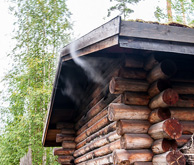About Sauna Bathing

Since ancient times sauna has been a magic environment for people to communicate, reinvigorate, restore their health, and evolve spiritually. Sauna integrates fire, water, air, and earth — the four primal elements of the universe. Perhaps, that's why it has such a versatile effect. Sauna cleanses, heals, and fills up with vital energy. In addition, the body produces the "happy hormones" endorphins under the influence of heat. There is much more to it than just spending one's leisure time. Finnish politicians even used to conduct top-level international negotiations in saunas a few decades ago.
Finland is considered a homeland of saunas because Finnish people love them like nowhere else. Although bathhouses were also being built all the time in many countries, like ancient Greece, Egypt, China, and India. The native people of North America were using saunas to communicate with spirits. Eastern European kings bathed in saunas regularly during the Middle Ages. Whereas Louis XIV of France totally ignored them since washing yourself was against the rules of local etiquette due to supposed harm to one's health. The consequences were all too obvious. In one of his letters, the Russian ambassador wrote: "His Majesty stinks like a wild animal." Fortunately, in due course, bathing restored its authority.

Many variations of saunas were developed in different countries. Turkish, Finnish, Russian, Japanese, dry, steam, white, black, smoke, infrared &mdash are all types of bathhouses. The principle difference is the level of humidity. Some use mainly heated air (dry or Finnish sauna), while others are filled with hot vapor (steam, Turkish, or Russian). Black or smoke sauna doesn't have a chimney. It is heated well at first, and only then bathers can come inside.
Additionally, perfumes and incense sticks are occasionally used in saunas. Some bathers like to massage each other with bunches of birch branches and leaves. Japanese sauna visitors submerge themselves into bathtubs. Indian saunas have heated floors. Even the heat yoga called Bikhram has originated. It is practiced in a room heated to 40 °C (104 °F) with a humidity of 40%. Generally speaking, the scale of sensations is quite extensive.
But is it possible to heal diseases by visiting a sauna? Scientific studies confirm the positive effect. Many New York rescue workers (policemen, firefighters, and others) were exposed to toxic substances during the Twin Towers collapse on September 11, 2001. It provoked respiratory, digestive disorders, depression, and irritability. Some of them decided to participate in a sauna detoxification program that lasted 30 days on average. Consequently, 84% of the participants recovered and no longer needed medicines.
The benefits of a sauna for one's health are the following:
- - Relaxation.
- - Alleviation of stress.
- - Better sleep.
- - Detoxification.
- - Good hangover remedy.
- - Glowing skin.
- - Cleaning of lungs (especially in the steam sauna).
- - Improving kidneys and liver.
- - Pain reduction.
- - Strengthening the immune system.
- - Relief for autoimmune diseases.
I have dealt with this topic more extensively in a separate article.
The sauna evokes the feeling of euphoria and inner fulfillment. The space transforms, and everyday problems become less relevant and heavy. There are no generals in the sauna, as the saying goes. However, Finnish President Urho Kekkonen was conducting negotiations in his private sauna with USA and Soviet leaders during the Cold War. Nobody was allowed to leave the sauna until the agreement was reached — such was the main principle of sauna diplomacy. Yet, for others, the sauna is a source of inspiration. "Solitude allows you moments of creativity, and some of my characters were actually born under extreme circumstances in the heat of the sauna," says famous actor Jonny Depp. But neither status nor position matters because everybody becomes equal in the sauna. Terms of bliss are entirely simple at times.
